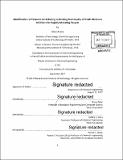Identification of features contributing to binding promiscuity of small-molecule inhibitors for rapidly mutating targets
Author(s)
Arora, Ishan
DownloadFull printable version (3.159Mb)
Other Contributors
Massachusetts Institute of Technology. Department of Chemical Engineering.
Advisor
Bruce Tidor and Hadley D. Sikes.
Terms of use
Metadata
Show full item recordAbstract
HIV infection has become a persistent worldwide epidemic despite the continuous development of novel inhibitors. A key challenge in combating HIV and other pandemic viral infections is the ability of the virus to mutate at an enormous rate and rapidly develop resistance to existing drugs. Among the various strategies that have been explored for the design of broadly binding HIV protease inhibitors, the substrate envelope hypothesis which is based on the idea of designing drugs that mimic the structural features of substrates has proved particularly effective. However, studies aimed at probing the substrate envelope hypothesis have found that the substrate envelope is a contributory but not sufficient property for robust binding and hence it is important to develop a better understanding of the other factors that contribute to binding promiscuity. This study investigated the key features which differentiate robust HIV protease inhibitors from susceptible HIV protease inhibitors by examining the interactions of certain known flat and nonflat binders with the different residues of HIV protease in terms of binding energy and number of contacts and correlating this analysis with the information about the mutational space of the virus. It was found that the promiscuous inhibitors, susceptible inhibitors and substrates all interact with the same set of HIV protease residues, some of which are vulnerable to primary mutations. The total contribution to the binding of an inhibitor/substrate to HIV protease from the HIV protease residues that are associated with primary mutations was observed to be a vital attribute separating flat binders from susceptible binders, with a greater contribution to binding from these residues translating into a higher susceptibility of the inhibitor to primary mutations. Certain strategies were proposed for incorporating these inferences in the computational drug design framework in order to generate robust HIV protease inhibitors. Although the analysis in this project was carried out using HIV protease as the model system, it is envisaged that the results obtained here would be generalizable to other rapidly mutating targets and hence these insights would facilitate drug design in the case of the outbreak of new epidemics of highly mutable infectious agents.
Description
Thesis: S.M., Massachusetts Institute of Technology, Department of Chemical Engineering, 2017. Cataloged from PDF version of thesis. Includes bibliographical references (pages 21-27).
Date issued
2017Department
Massachusetts Institute of Technology. Department of Chemical EngineeringPublisher
Massachusetts Institute of Technology
Keywords
Chemical Engineering.